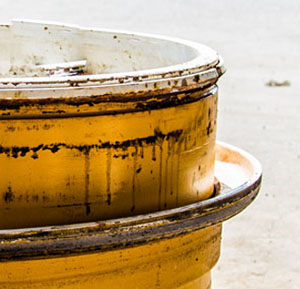Wheels and tyres come in a wide variety of sizes and combinations. If not correctly inflated or deflated, as with split-rims, they can cause a serious injury or even death. One of the major contributors to injury is the over-inflation of tyres due to them being left unattended.

Tyres
Air-filled tyres can explode when over pressurising or defective.
Whether new or used, tyres need to be checked for defects before fitting onto a rim or wheel.
Defects may include:
- perishing on tyres
- delamination inside or outside
- wavy tyre walls
- side wall damage, which may lead to zipper failures.
All defective tyres should be disposed of appropriately.
If the tyre is heavily soiled, dirt and debris may need to be removed so that the tyre can be properly inspected for defects. You may not be able to see all defects during inspection, take care when inflating.
If a tyre has been overloaded, or the pressure has dropped below 80% of capacity, remove the tyre from the rim after control deflation of the tyre and inspect it before refitting and inflating it.
Running with pressure below 80 percent (or overloading) can lead to fatigue failures, like zipper failure (a circumferential fracture of the side wall of the tyre).
For dual-wheel assemblies, it is hard to see if the pressure of one tyre has dropped below 80 percent of the recommended pressure, so always use a gauge to measure the pressure.
When inflating:
- don’t inflate tyres beyond the maximum cold pressure recommended by the manufacturer (this information should be available on the vehicle)
- use airlines fitted with adjustable pressure regulators to prevent exceeding maximum pressure
- always use an inline gauge to check tyre pressure
- always keep away from the sidewall (eg the flat area on either side of the rolling direction of the tyre), even when the wheel is restrained
- use a long air hose with at least three metres of length after the gauge and trigger and a clip on air chuck to keep at a safe distance
- always use a safety cage.
Compressed air
Compressed air is used for inflating tyres.
Air receivers can explode and cause serious injuries or death if they are not properly inspected and maintained, or if they have been operated above the design pressure.
Air receivers are to be inspected and maintained in accordance with the manufacturers recommendations, if there are no manufacturers recommendations available then act on the advice of a competent person, if none of these steps are reasonably practicable then at least annually.
The Safe Work Australia compressed air and air receiver information sheet provides more guidance and information.
Split rims

Split rims are different from regular wheels found on most cars. Most cars we drive have wheels that have a single piece of metal with the rubber tyre inflated around it (which is then secured to your vehicle).
Spilt rims are multi-piece-or-divided rims and wheels that are held together by bolts or a lock ring.
Split rims are not usually used in cars or light vehicles, but can be found on some four-wheel drives, and:
- earth moving machinery
- forklifts
- tractors
- large trucks.
If you have split rims, it’s very important you deflate the tyre before removing it from the vehicle and take care when inflating, otherwise they can explode causing serious injury or death.
Further information
- The Safe Work Australia guide for split rims and compressed air and air receiver information sheet, provide more information for workers who:
- carry out work including tyre fitting or, vehicle and machinery repairs on wheel like divided wheels, multi-piece rims or multi piece wheels
- conduct work involving the use of large or small scale air compressors and air receivers.
- You can also watch the SafeWork NSW split rims video safety alert.
Acknowledgement: Information and images sourced from SafeWork NSW.




